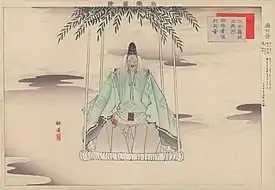The Priest and the Willow
The Priest and the Willow (遊行柳, Yugyō yanagi) is a Noh play based on the experiences of the 12th-century poet and travelling-monk Saigyō.[1]

Original kernel
Saigyō was travelling to North Japan, when he sat in the shade of a willow-tree, later identified by Bashō as being close to the village of Ashino,[2] and wrote a waka: " ‘Just a brief stop,’/ I said when stepping off the road/into a willow's shade/where a bubbling stream flows by,/as has time since my ‘brief stop’ began".[3]
Main theme
A wandering priest, Yugyō Shonin, is given directions by an old man who recites Saigyō's poem before vanishing: the priest then realises it was the spirit of the willow tree.[4] By reciting a prayer to Amida Buddha, he enables the spirit to attain Buddhahood, for which the willow spirit thanks him in a dance sequence.[5]
Later developments
Buson wrote a haiku on rocks and willows underneath the Pilgrim's Willow Tree, alluding to the Noh play.[6]
See also
References
- L Zolbrod, Haiku Painting (Tokyo 1982) p. 14
- Basho, The Narrow Road to the Deep North (Penguin 1983) p. 105
- W LaFleur trans, Awesome Nightfall (Boston 2003) p. 143
- Summary and Highlights of Yugyō yanagi
- Summary and Highlights of Yugyō yanagi
- L Zolbrod, Haiku Painting (Tokyo 1982) p. 12